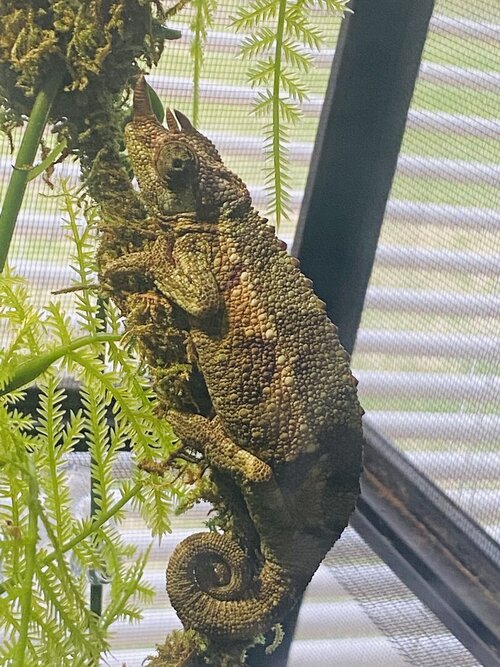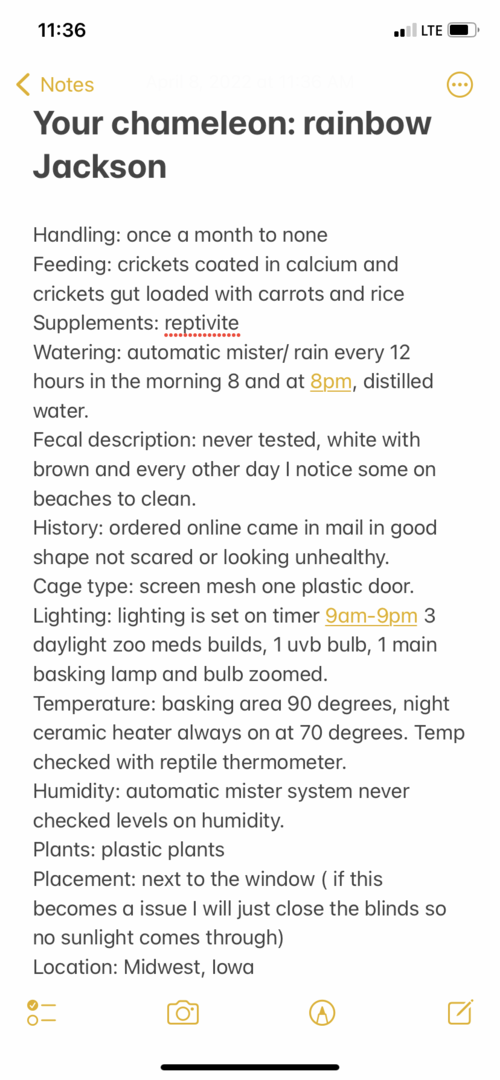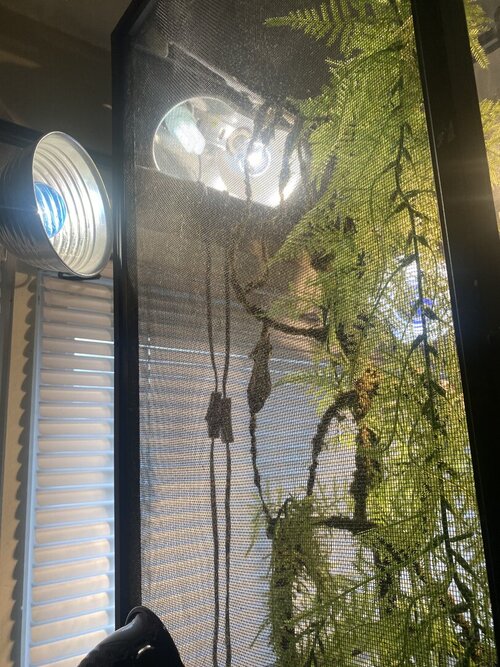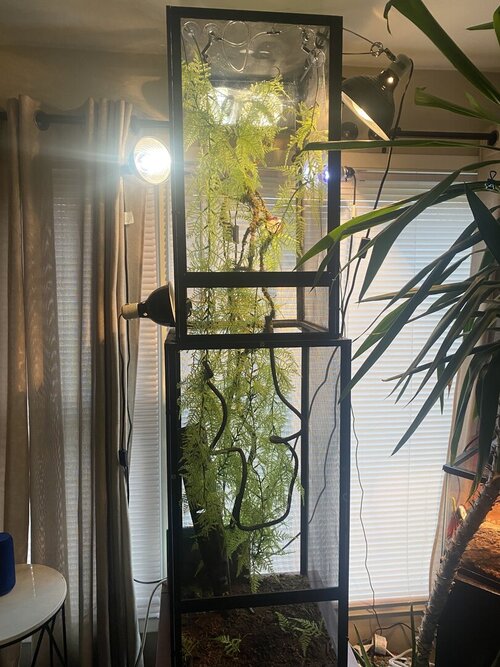Navigation
Install the app
How to install the app on iOS
Follow along with the video below to see how to install our site as a web app on your home screen.
Note: This feature may not be available in some browsers.
More options
You are using an out of date browser. It may not display this or other websites correctly.
You should upgrade or use an alternative browser.
You should upgrade or use an alternative browser.
Rainbow Jackson chameleon
- Thread starter Gtcrazy
- Start date
Sonny13
Chameleon Enthusiast
How old is he/she? First guess would also be female, because of the smaller horns and the patterns/colors. And correct, female rainbow Jackson’s have horns.
Maybe you have seen this….if not, this could also be helpful
https://chameleonacademy.com/wp-con...t-Machakos-Hills-Jacksons-Chameleon-2021B.pdf
Maybe you have seen this….if not, this could also be helpful
https://chameleonacademy.com/wp-con...t-Machakos-Hills-Jacksons-Chameleon-2021B.pdf
Gtcrazy
New Member
PostedI'm leaning toward female but I can't certain until I see a side view of the tail extended.
Gtcrazy
New Member
I believe she’s about 2 months to 3 and I have artificial plants I’m starting to lean over to the idea of real plants though. It’s kind of hard to hang pots in her enclosure since it’s very tall about 6 feet.Keeping up with my guess for female.
Are you also keeping live plants in her enclosure? Or just the artificial ones?
Sonny13
Chameleon Enthusiast
There´s no direct need for hanging, you can always place a large centrepiece plant with pot inside the enclosure. Trust me, it´s rewarding giving them some real plants and foliage to hide in. It also benefits in humidity and drinking (they the drops from the leaves).I believe she’s about 2 months to 3 and I have artificial plants I’m starting to lean over to the idea of real plants though. It’s kind of hard to hang pots in her enclosure since it’s very tall about 6 feet.
Some excellent centrepieces are i.e. Schefflera´s or Ficus Alii and something from below list also check this for some inspiration https://www.chameleonforums.com/blogs/low-budget-enclosure-setup.2462/
Gtcrazy
New Member
There´s no direct need for hanging, you can always place a large centrepiece plant with pot inside the enclosure. Trust me, it´s rewarding giving them some real plants and foliage to hide in. It also benefits in humidity and drinking (they the drops from the leaves).
Some excellent centrepieces are i.e. Schefflera´s or Ficus Alii and something from below list also check this for some inspiration https://www.chameleonforums.com/blogs/low-budget-enclosure-setup.2462/
View attachment 322688
Sonny13
Chameleon Enthusiast
For the easiest feedback, I would suggest filling out the following form, just copy/paste and complement it.
They´re some things needed to be corrected to give her the best possible life. Seeing her room one big question pops up directly. What are your nights temps in the room she is in? Because this would be the most important thing for now.
Chameleon Info:
Cage Info:
They´re some things needed to be corrected to give her the best possible life. Seeing her room one big question pops up directly. What are your nights temps in the room she is in? Because this would be the most important thing for now.
Chameleon Info:
- Your Chameleon - The species, sex, and age of your chameleon. How long has it been in your care?
- Handling - How often do you handle your chameleon?
- Feeding - What are you feeding your cham? What amount? What is the schedule? How are you gut-loading your feeders?
- Supplements - What brand and type of calcium and vitamin products are you dusting your feeders with and what is the schedule?
- Watering - What kind of watering technique do you use? How often and how long to you mist? Do you see your chameleon drinking?
- Fecal Description - Briefly note colors and consistency from recent droppings. Has this chameleon ever been tested for parasites?
- History - Any previous information about your cham that might be useful to others when trying to help you.
Cage Info:
- Cage Type - Describe your cage (Glass, Screen, Combo?) What are the dimensions?
- Lighting - What brand, model, and types of lighting are you using? What is your daily lighting schedule?
- Temperature - What temp range have you created (cage floor to basking spot)? Lowest overnight temp? How do you measure these temps?
- Humidity - What are your humidity levels? How are you creating and maintaining these levels? What do you use to measure humidity?
- Plants - Are you using live plants? If so, what kind?
- Placement - Where is your cage located? Is it near any fans, air vents, or high traffic areas? At what height is the top of the cage relative to your room floor?
- Location - Where are you geographically located?
Interesting cage set up. I see a few problems with it being that close to a window. Unfortunately glass doesn't let in enough UVB. Your chameleon isn't going to know that and is going to seek out the window light rather than your UVB lights and will be subject to metabolic bone disease. Regulating the temperature will also be an issue.
I will check back later to see what your answers are to the questions posted above.
Another note you will be able to hang pots from the sides of your cage to fill in if necessary. You will need a lot of plants to maintain a steady humidity.
I will check back later to see what your answers are to the questions posted above.
Another note you will be able to hang pots from the sides of your cage to fill in if necessary. You will need a lot of plants to maintain a steady humidity.
Here are some links for now.
My Jackson's Supplement Schedule
My Jackson's Supplement Schedule
- This is the caresheet from this site if you haven't seen it and you want to take care of a Jackson's Chameleon read it. https://www.chameleonforums.com/care/caresheets/jacksons/
- An alternate care sheet from the Chameleon Academy also very good
https://chameleonacademy.com/the-jacksons-chameleon-trioceros-jacksonii/ - Article on the three recognized species of Jackson's Chameleons and some care and breeding information. Chameleons Online E-Zine by Kent Manchen http://www.chameleonnews.com/10JulManchen.html
Gtcrazy
New Member
For the easiest feedback, I would suggest filling out the following form, just copy/paste and complement it.
They´re some things needed to be corrected to give her the best possible life. Seeing her room one big question pops up directly. What are your nights temps in the room she is in? Because this would be the most important thing for now.
Chameleon Info:
- Your Chameleon - The species, sex, and age of your chameleon. How long has it been in your care?
- Handling - How often do you handle your chameleon?
- Feeding - What are you feeding your cham? What amount? What is the schedule? How are you gut-loading your feeders?
- Supplements - What brand and type of calcium and vitamin products are you dusting your feeders with and what is the schedule?
- Watering - What kind of watering technique do you use? How often and how long to you mist? Do you see your chameleon drinking?
- Fecal Description - Briefly note colors and consistency from recent droppings. Has this chameleon ever been tested for parasites?
- History - Any previous information about your cham that might be useful to others when trying to help you.
Cage Info:
- Cage Type - Describe your cage (Glass, Screen, Combo?) What are the dimensions?
- Lighting - What brand, model, and types of lighting are you using? What is your daily lighting schedule?
- Temperature - What temp range have you created (cage floor to basking spot)? Lowest overnight temp? How do you measure these temps?
- Humidity - What are your humidity levels? How are you creating and maintaining these levels? What do you use to measure humidity?
- Plants - Are you using live plants? If so, what kind?
- Placement - Where is your cage located? Is it near any fans, air vents, or high traffic areas? At what height is the top of the cage relative to your room floor?
- Location - Where are you geographically located?
Attachments
Most urgent things first 90 F is far to hot for this species. 80-82 F is as high as I will go for mature males. You need to either move the bulb farther up and away from the cage or get a lower wattage. I use 40, 50 or 60 watts depending on age and ambient temperature factors. You don't need to add heat at night except to stay above 50 F at night in rare situations, probably not yours. They thrive on cooler nights 60 F is preferred.
I can't get a good look at your lighting in your cage pictures but if you don't have a linear UVB bulb and fixture the length or width of the top of your cage you will need to upgrade quickly. The coil or short loop bulbs don't supply enough UVB. I know it sucks to hear you have to come up with even more supplies to do this right but it's the truth. All of your lighting needs to be mounted on or above the cage top. It's what works for these arboreal species.
After she settles in get a fecal sample to the vet treating for parasites before she gets sick makes for a more successful treatment.
Reptivite is a multivitamin it can be used once a month in this species. It is not my favorite brand. If you use it daily she will soon get sick from an over dose of vitamins. If you also have a plain phos. free calcium you can use that 2-3 times per week and use the multi monthly if you have the kind with D3. Your gut load will need more variety of other vegetables from the list that follows. You will not need the rice.
Suggested Ingredients
Best - These gutloading ingredients are best because they are highest in calcium, low in phosphorus, oxalates and goitrogens. They should be the primary components of your gutload: mustard greens, turnip greens, dandelion leaves, collard greens, escarole lettuce, papaya, watercress and alfalfa.
Good - These gutloading ingredients are good because they are moderately high in calcium and other vitamins/minerals. They should be used in addition to those from the previous category: sweet potato, carrots, oranges, mango, butternut squash, kale, apples, beet greens, blackberries, bok choy and green beans.
You may want to add a dripper to your midday somewhere to give her an extra opportunity to drink.
Attachments
Gtcrazy
New Member
View attachment 322703
Most urgent things first 90 F is far to hot for this species. 80-82 F is as high as I will go for mature males. You need to either move the bulb farther up and away from the cage or get a lower wattage. I use 40, 50 or 60 watts depending on age and ambient temperature factors. You don't need to add heat at night except to stay above 50 F at night in rare situations, probably not yours. They thrive on cooler nights 60 F is preferred.
View attachment 322704
I can't get a good look at your lighting in your cage pictures but if you don't have a linear UVB bulb and fixture the length or width of the top of your cage you will need to upgrade quickly. The coil or short loop bulbs don't supply enough UVB. I know it sucks to hear you have to come up with even more supplies to do this right but it's the truth. All of your lighting needs to be mounted on or above the cage top. It's what works for these arboreal species.
View attachment 322701
After she settles in get a fecal sample to the vet treating for parasites before she gets sick makes for a more successful treatment.
View attachment 322706
Reptivite is a multivitamin it can be used once a month in this species. It is not my favorite brand. If you use it daily she will soon get sick from an over dose of vitamins. If you also have a plain phos. free calcium you can use that 2-3 times per week and use the multi monthly if you have the kind with D3. Your gut load will need more variety of other vegetables from the list that follows. You will not need the rice.
Suggested Ingredients
Best - These gutloading ingredients are best because they are highest in calcium, low in phosphorus, oxalates and goitrogens. They should be the primary components of your gutload: mustard greens, turnip greens, dandelion leaves, collard greens, escarole lettuce, papaya, watercress and alfalfa.
Good - These gutloading ingredients are good because they are moderately high in calcium and other vitamins/minerals. They should be used in addition to those from the previous category: sweet potato, carrots, oranges, mango, butternut squash, kale, apples, beet greens, blackberries, bok choy and green beans.
You may want to add a dripper to your midday somewhere to give her an extra opportunity to drink.
Attachments
Similar threads
- Replies
- 32
- Views
- 5K











